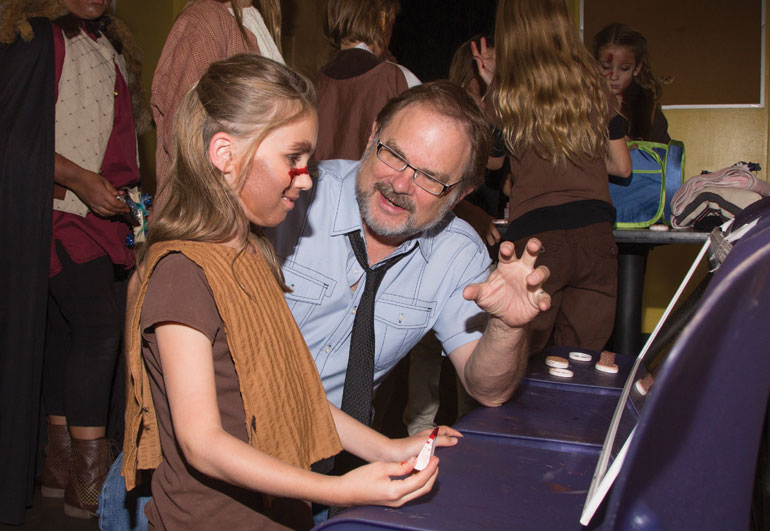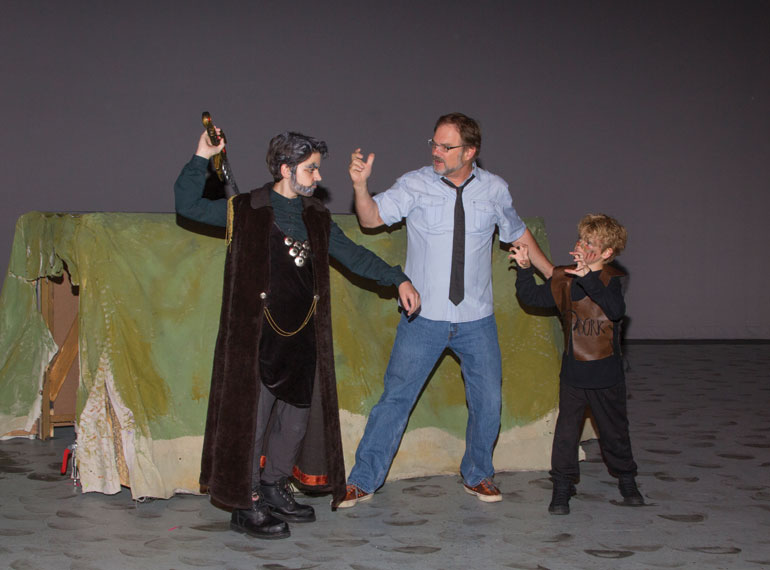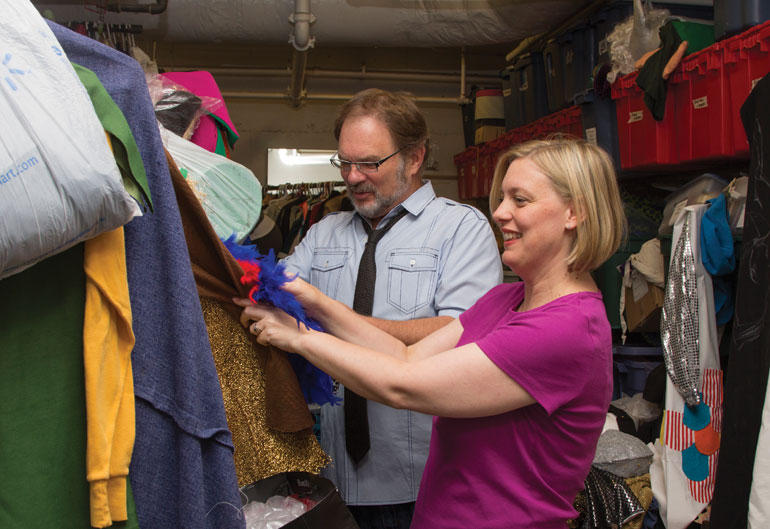| 2014 Q3 | story by ANNE BROCKHOFF | photos by STEVEN HERTZOG |

Olivia Goeser getting last minute direction from Lawrence Arts Center Artistic Director of Performing Arts, Ric Averill.
The fearsome Mouse King, vanquished by the Nutcracker and dragged offstage by a cadre of tiny mice during “A Kansas Nutcracker.” The bow-tied and sneakered auctioneer at the annual Lawrence Arts Center Benefit Arts Auction. The director, collaborating with musicians, choreographers, dancers and actors to create next spring’s version of Prokofiev’s “Peter and the Wolf.”
They’re roles played by Ric Averill, the arts center’s director of performing arts and a mainstay in the local theater community for four decades. During that time, Averill’s acted in, directed, produced, written, composed music for and conducted countless productions, flexing his creative muscles while helping turn Lawrence truly into a city of the arts.
“Lawrence is growing right now, in part, on the basis of being an arts town,” Averill said, who curates dance, music, film, theater and interdisciplinary arts for the arts center. “Performing arts are a vital part of that.”
Art is good for business, Averill says. It contributes to quality of life, which helps attract employers and employees. Patrons also eat at restaurants, out-of-towners book hotel rooms and both shop here. The arts center itself advertises in Lawrence media and sources supplies for sets, costumes and props from area businesses.
Some of those are used in professional productions, such as “Sweeney Todd,” the premier of “MotherF#$^*ingHood” and the upcoming “The Nervous Set: a Jazz Musical of the Beat Generation.” Some are educational, like the Summer Youth Theater program, which this year included four plays with 300 children in acting and technical roles.
However, most blend the talents of professional, amateur and student actors, dancers and musicians. The results are “interesting hybrids,” such as “A Kansas Nutcracker,” a mix of theater and ballet that Averill wrote and scored. This fall’s “The Halloween Monster Ball,” a collaboration between the arts center’s school of dance and Lawrence Ballet Theater with music written by Averill.
“It becomes this conglomerate of different age groups and people who then learn from each other,” Averill said. “You learn so, so much.”
Averill may love theater, but his youthful ambition was to become a composer. He received a Bachelor of Fine Arts with highest distinction in music composition from the University of Kansas in 1972. His wife, Jeannie, also holds degrees in education and theater from KU and is an equity and screen actress, who last year retired from teaching at Lawrence High School. The couple raised their children here, Will Averill and Trish Averill Neuteboom, both of whom also have careers in theater.
In 1973, the Averills founded the Mead Hall Players in what is now the Jazzhaus at 926-1/2 Massachusetts Street. Initially, they presented two short plays with vaudeville-style entertainment in between; children’s theater soon made the mix.
“We had this crazy idea that it would be easy and make lots of money,” Averill said. “It was neither. But it became my life’s passion, creating work for youth.”

Left to right: Jared Cote, Averill and Sam Girard practicing a performance. This year, the Summer Youth Theater program included four plays with 300 children in acting and technical roles.
He began by writing short adaptations of fairy tales, and then created the serialized adventures of “Nyfrm the Sprite.” When the Averills’ company joined the arts center in the Carnegie Building in 1975, they renamed it the Seem-to-Be Players. The name comes from characters out of an early Nyfrm episode, three sisters who could become whatever they seemed to be, essential transformational theater characters, Averill calls them.
At the same time, Averill, who was producing concerts and plays for adult audiences, had started the Kaw Valley School of Crafts and Performing Arts and took over the Apple Valley Theater near Lake Pamona. So, of course seemed like a good time to go back to graduate school, too.
He returned to KU and in 1984 received a Master of Fine Arts in children’s theatre, with an emphasis on playwriting. While in grad school, he’d toured with the Kansas University Theater for Young People and saw similar potential for the Seem-to-Be Players.
So, he took the company on the road. By the late 1980s, it was performing in schools and communities across Kansas and the Midwest with grant support from the National Endowment for the Arts, Kansas Arts Commission, Mid-America Arts Alliance and others.
Averill continued honing his writing skills, and he soon was producing longer adaptations and original plays that earned national acclaim. One of those was “T-Money & Wolf,” which Averill wrote in 1993 with filmmaker Kevin Willmott. It was his first to be published by Dramatic Publishing Company; the company now carries another two-dozen of Averill’s titles.
“T-Money & Wolf” was also Averill’s first to be included in The Kennedy Center’s New Visions/New Voices, a biennial festival for plays written for young audiences. He later returned with “The Emperor’s New Clothes: an Opera for Children and Dreams Carved from Stone,” a play about the life of Crazy Horse Memorial sculptor Korczak Ziolkowsky commissioned by the Children’s Theatre Company of Sioux Falls.
The Kennedy Center also commissioned an adaptation of “Alice in Wonderland” from Averill, including it in its 1993-94 Performances for Young Audiences season. The play then toured for two months, reaching an estimated audience of 23,000 during 63 performances at 10 venues in nine states.
Others of Averill’s plays were selected for The Waldo M. and Grace C. Bonderman National Youth Theatre Playwriting Competition and Symposium in Indianapolis. San Diego State University’s Theatre of the World Festival also produced staged readings or full productions of Averill’s plays every other year between 1995 and 2003, including “Los Zapatos Magicos,” “Grotesque Arabesque,” a rock opera based on the works of Edgar Allen Poe and “Escape from the Labyrinth,” the story of Theseus and Icarus.

Averill and “Hobbit” director, Ellen Anthony-Moore digging through costumes for upcoming performances. Averill began writing short adaptations of fairy tales, and then created the serialized adventures of “Nyfrm the Sprite.”
Averill participated in Peace Child International, a program that empowers kids to envision change through musical theater, in Narofominsk, Russia in 1990. He became active in the leadership of organizations including the American Alliance for Theatre & Education, Theatre for Young Audiences/USA and International Performing Arts for Youth.
“Through those boards, I found a national family of people who do the things I do,” Averill said.
How Averill was doing those things was soon to change, however. The new millennium brought new challenges for the Seem-to-Be Players, an economic climate that eroded arts funding and a shift in education policy that drove schools to favor adaptations more closely tied to their curricula over original plays.
Rather than fight those forces, the Seem-to-Be Players gave its final local performance of Rapunzel in 2008 and toured for the last time in 2009 with a Fish Tank Theater production called “The Coppelia Project.”
“We had a wonderful run,” Averill said of the company. “We toured for 30-plus years and had been to every state but five and a couple of different countries.”
Averill’s focus is now on arts center offerings. His is a multi-arts approach, one that combines theater, music and dance and feeds off the creative energy produced by the print makers, ceramicists, painters, sculptors and other visual artists who fill the building.
“We get a chance to engage in those art forms, and we also expand what we do in our own,” Averill said, who himself has taken ballet classes for the past 10 years.
It’s serious work. Take theater. It provides a forum for not just entertainment, but social change, exploration of history and challenging thinking, Averill says. Certainly that happens on the adult and professional level, the arts center is uniquely positioned to give children from elementary to high school that same opportunity.
All of the youth classes and programs meet at the Kennedy Center for the Performing Arts’ National Theater Standards, and seek to develop students’ theater literacy by exposing them to every aspect of a production, from acting and improvisation to playwriting, set design and directing.
Some veterans of the program do go on to professional careers. Averill points to two: Noel Olson and Alex Kipp both took arts center classes as kids and both have roles in “The Nervous Set.”
Even those who don’t go pro benefit, though, Averill says. Acting out stories is a form of kinesthetic learning, one that deepens a child’s understanding of literature, issues and history. Theater’s also a perfect for helping young people develop a sense of community and empathy for others, according to Averill.
“Kids are still facing the same issues of acceptance, love, tolerance, intolerance, cooperation and kindness,” Averill said. “If there’s anything I would want students and families to pick up, is to walk out of here having a better perception of our shared humanity. That we’re all in this together, and we can make things better by listening to each other.” ■
